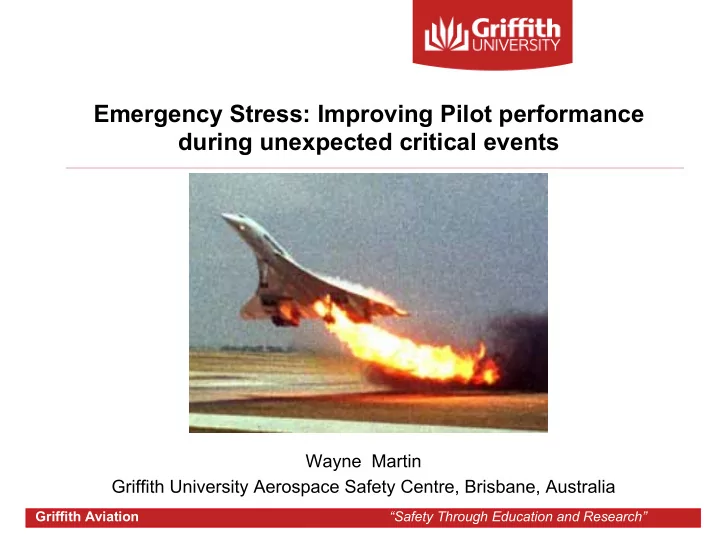

Emergency Stress: Improving Pilot performance during unexpected critical events Wayne Martin Griffith University Aerospace Safety Centre, Brisbane, Australia Griffith Aviation “Safety Through Education and Research” Griffith Aerospace Safety Centre
Griffith Aerospace Safety Centre
The curse of ubiquitous normalcy The ubiquitous reliability of the modern aircraft has done tremendous things for airline safety. One of the by-products of this tremendous reliability however, is a semi-realistic expectation amongst pilots that things will very rarely ever go wrong.
A conditioned expectation of normalcy While Pilots may practise emergencies in a simulator for perhaps an avarage of four days a year, the remainder of the 360+ days are often routine and emergency-free. On those rare occasions when things do go wrong, then a lack of expectation and sense of self-efficacy can produce some heightened stress reactions, with negative outcomes on situation outcome.
Some recent examples of unexpected events Turkish Airlines – Amsterdam 2009
Some recent examples of unexpected events Colgan Air – Buffalo 2009
Some recent examples of unexpected events Air France – Atlantic Ocean 2009
Emotional Response in the Human brain So why do pilots underperform during these critical events? The answer lies in the brain….
Emotional Response in the Human Brain CG Freezing Amygdala Emotional Stimulus Blood LH Pressure Thalamus LA CE PVN Hormones Startle RPC Reflex
Emotional Response in the Human Brain SENSORY CORTEX PROCESSING ROUTE (700+ms) QUICK and DIRTY ROUTE SENSORY AMYGDALA THALAMUS (14+ms) EMOTIONAL EMOTIONAL STIMULUS RESPONSE
Emotional Response Amygdala (Fight or Flight) Hypothalamus Activates Activates the adrenal- sympathetic cortical system by nervous system releasing CRF Activates Pituitary Gland adrenal secretes hormone medulla ACTH Impulses Releases Releases ACTH arrives at the activate norepinephrine epinephrine adrenal cortex and glands and releases approx. 30 smooth hormones muscles bloodstream Neural activity combines with hormones in the bloodstream to constitute fight-or-flight response
Emotional Response in the Human body Activation of the sympathetic nervous system then has the following effects: § dilates the pupils and opens the eyelids § stimulates the sweat glands § increases the heart rate § opens up the bronchial tubes of the lungs § inhibits the secretions in the digestive system § creates auditory exclusion and tunnel vision § dilates the blood vessels in large muscles (300% increase in blood flow) § constricts the blood vessels in the rest of the body § diminishes processing in the frontal cortex
Dynamic Mortality Salience Mortality Salience is: ‘the enhanced awareness that people engaged in dangerous tasks have of the likelihood of personal injury or death’ In the context of an aircraft emergency, this realisation presents itself as an appraisal that a situation is life threatening or potentially ‘harmful’. Griffith Aerospace Safety Centre
A ¡Conceptual ¡Model ¡of ¡Appraisal ¡and ¡Information ¡Processing ¡ Environmental Event Primary Appraisal Loss/ Harm Benign, Positive Threat/Challenge or Irrelevant Secondary Appraisal Defence or Coping Reappraisal Mechanism Employed Problem Focussed Emotion Focussed Ignore Assign Attentional OR Coping Coping Resource Attentional Perception Channelling Normal Information Perception Processing Degraded Information Processing
NATURALISTIC DECISION MAKING Attention and Perception Eyes Ears Situation Choice Action Nose Cues Assessment Touch Taste Hypothesis Risk Action Generation Assessment Generation Long Term Memory Griffith Aerospace Safety Centre
REDUCING PATHOLOGICAL STRESS EFFECTS So how do we improve performance under acutely stressful conditions? - By increasing level of expectation - By increasing knowledge breadth and depth to allow more experiential based choices during naturalistic decision making - By increasing sense of efficacy and thereby engendering more positive appraisals Griffith Aerospace Safety Centre
What would you do if....? § A ten week pilot study at a New Zealand based International Airline § Designed to gauge attitudes to scenario based discussions of novel and emergency inflight events § Participants encouraged to discuss during quiet periods in the cruise, what they would do if something unusual and/or unexpected happened § Very positive results Griffith Aviation “Safety Through Education and Research” Griffith Aerospace Safety Centre
Do you think that these discussions have raised your expectation level for surprise events? Griffith Aviation “Safety Through Education and Research” Griffith Aerospace Safety Centre
As a result of these discussions do you think that you would be better prepared to handle one of these novel or emergency events if it happened unexpectedly? Griffith Aviation “Safety Through Education and Research” Griffith Aerospace Safety Centre
Summary § The ubiquitous reliability of the modern aircraft engenders a conditioning toward an expectation of normalcy. § The key to overcoming pathological stress effects arising from this conditioned state, is to increase expectation and efficacy amongst the pilot group. § While scenario based learning is common in military and training operations, a change in pilot culture is needed to make this common place in normal line operations. Griffith Aviation “Safety Through Education and Research” Griffith Aerospace Safety Centre
Summary § Interventions such as IATA’s ITQI / EBT are starting to focus training interventions on the type of events that do occur most regularly in modern aircraft. § As well as the common problems, these types of initiatives also allow pilots to practise managing ‘black swan’ or rare event scenarios, and to develop some strategies for dealing with unusual events. § Holistically applied initiatives to develop Pilot efficacy and management capabilities can only have positive effects on performance under stress. Griffith Aviation “Safety Through Education and Research” Griffith Aerospace Safety Centre
QUESTIONS? Griffith Aerospace Safety Centre
Recommend
More recommend